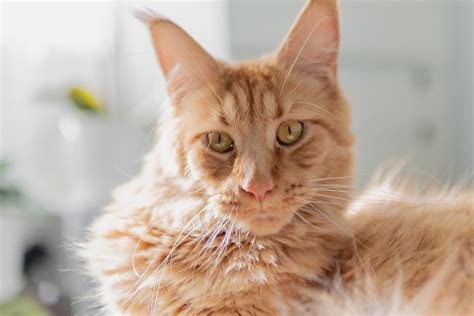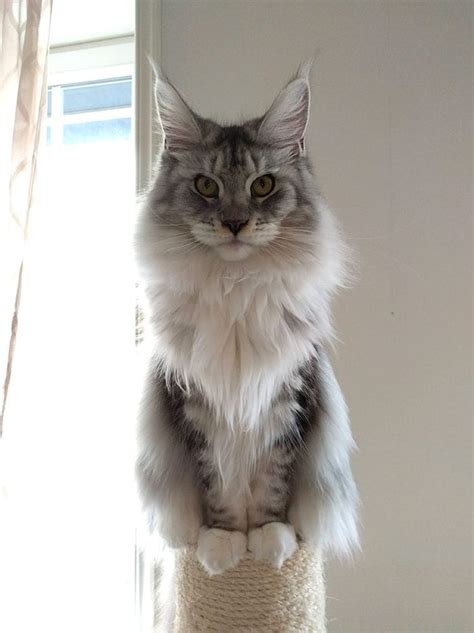
A Maine Coon cat named Leo has captivated the internet with his insistent demands to be let outside, showcasing the breed’s known intelligence and desire for outdoor adventures. His owner, using a pre-recorded button that says “Outside, Now!”, has documented Leo’s frequent and clear communication, leading to viral fame and highlighting the increasing trend of pet owners using augmentative and alternative communication (AAC) devices with their animals.
Leo, the vocal Maine Coon, has become an internet sensation thanks to his persistent and adorable demands to explore the great outdoors. His owner, as documented on social media platforms, utilizes a custom sound button that, when pressed, audibly proclaims, “Outside, Now!” Leo’s frequent and deliberate use of this button has not only amused countless viewers but has also sparked conversations about feline intelligence, the unique characteristics of the Maine Coon breed, and the growing trend of pet owners employing augmentative and alternative communication (AAC) devices to better understand and respond to their animal companions.
The videos showcasing Leo’s insistent requests have rapidly spread across various social media channels, garnering millions of views and countless comments. Viewers are charmed by Leo’s unwavering determination and the clarity with which he expresses his desire to venture outside. The clips typically feature Leo approaching the sound button, often multiple times in quick succession, and pressing it with his paw, resulting in the emphatic declaration, “Outside, Now!” His owner then usually obliges, allowing Leo to embark on his desired outdoor escapades.
This seemingly simple interaction has resonated deeply with pet lovers worldwide, underscoring the powerful bond between humans and animals and highlighting the sophisticated communication skills that animals, particularly cats, possess. Furthermore, Leo’s story sheds light on the increasing awareness and acceptance of AAC devices as tools for enhancing communication with pets.
The Maine Coon breed, known for its large size, gentle demeanor, and above-average intelligence, is particularly well-suited to this type of communication. “Maine Coons are known for being intelligent and communicative cats,” experts note, “making them ideal candidates for learning to use AAC devices.” Their inherent curiosity and desire for interaction make them receptive to training and eager to engage with their owners in meaningful ways.
The use of AAC devices with pets is not entirely new, but it has gained significant traction in recent years, fueled by advancements in technology and a growing understanding of animal cognition. These devices typically consist of a series of buttons, each programmed with a specific word or phrase. Through consistent training and positive reinforcement, pets can learn to associate the buttons with desired actions or objects, allowing them to express their needs and preferences more effectively.
While the effectiveness of AAC devices with pets is still a subject of ongoing research, anecdotal evidence suggests that they can significantly improve communication and strengthen the bond between humans and animals. Pet owners who utilize these devices often report a greater understanding of their pets’ needs, leading to improved care and a more harmonious relationship.
However, experts caution that the success of AAC device training depends on several factors, including the pet’s individual temperament, the owner’s dedication to training, and the consistency of the training regime. It’s also crucial to interpret the pet’s communication within the context of their behavior and environment, avoiding anthropomorphism and ensuring that their needs are genuinely being met.
Leo’s story serves as an inspiring example of how technology and a deeper understanding of animal behavior can enhance communication and improve the lives of both pets and their owners. His “Outside, Now!” demands have not only brought joy to millions but have also sparked a broader conversation about the potential for AAC devices to unlock new levels of understanding and connection with our animal companions.
The popularity of Leo’s videos also highlights the growing trend of pet owners seeking ways to enrich their pets’ lives and provide them with opportunities for mental and physical stimulation. For Maine Coons, in particular, access to the outdoors is often seen as essential for their well-being. Their natural curiosity and love of exploration make them eager to roam and investigate their surroundings.
However, allowing cats to roam freely outdoors also comes with potential risks, including traffic accidents, encounters with other animals, and exposure to diseases. Pet owners must carefully weigh the benefits of outdoor access against these risks and take appropriate precautions to ensure their cats’ safety. These precautions might include supervised outdoor time, enclosed cat patios (catios), or the use of GPS tracking devices.
Leo’s owner has not publicly disclosed the specific safety measures in place to protect him during his outdoor adventures, but it is reasonable to assume that they have taken precautions to minimize the risks. The focus of the videos is primarily on Leo’s communication and his adorable demands, rather than on the specifics of his outdoor environment.
Ultimately, Leo’s story is a testament to the power of communication and the enduring bond between humans and animals. His insistent “Outside, Now!” demands have captured the hearts of millions, reminding us of the intelligence, curiosity, and unique personalities of our feline companions. The trend of using AAC devices with pets, while still in its early stages, holds great promise for enhancing communication and improving the lives of animals everywhere.
The Maine Coon breed’s characteristics further amplify Leo’s story. They are often referred to as “gentle giants” due to their large size and affectionate nature. Their intelligence makes them highly trainable and receptive to learning new skills, while their playful and curious personalities make them eager to explore and interact with their environment. These traits, combined with their vocal nature, make them particularly well-suited for communicating their needs and desires.
In recent years, the use of technology to enhance pet care has become increasingly prevalent. From automated feeders and litter boxes to GPS tracking devices and interactive toys, pet owners are embracing technology to improve their pets’ lives and provide them with the best possible care. AAC devices represent another facet of this trend, offering a potentially transformative way to communicate with pets and understand their needs more effectively.
The ethical considerations surrounding the use of AAC devices with pets are also worth noting. Some critics argue that using these devices can lead to anthropomorphism, projecting human emotions and motivations onto animals. It is essential to approach the use of AAC devices with a clear understanding of animal behavior and to interpret their communication within the context of their natural instincts and needs.
Despite these potential challenges, the benefits of improved communication with pets are undeniable. By providing animals with a means to express their needs and preferences, we can improve their quality of life and strengthen the bond between humans and animals. Leo’s story serves as a compelling example of how this can be achieved, demonstrating the potential for AAC devices to unlock new levels of understanding and connection with our beloved companions.
The trend of pet communication extends beyond just cats and AAC devices. Dog owners have long used training techniques and verbal cues to communicate with their canine companions. However, even within the dog world, there are advancements in technology and communication methods. Some owners are now using wearable technology to monitor their dogs’ activity levels and identify potential health issues. Others are exploring the use of sign language or other forms of visual communication to enhance their communication with their dogs, particularly those with hearing impairments.
The study of animal cognition is also playing an increasingly important role in the development of pet communication tools and techniques. Researchers are continually learning more about the cognitive abilities of different animal species, which can inform the design of more effective communication methods. For example, studies have shown that dogs are capable of understanding human emotions and can even learn to recognize individual words. This knowledge can be used to develop training programs that are tailored to the specific cognitive abilities of each dog.
The impact of social media on the pet communication trend cannot be overstated. Platforms like Instagram, TikTok, and YouTube have become hubs for pet owners to share their experiences and learn from each other. Videos showcasing pets using AAC devices or engaging in other forms of communication have gone viral, inspiring countless others to try similar techniques with their own animals. This online community provides a valuable resource for pet owners to share tips, ask questions, and support each other in their efforts to better understand their pets.
Looking ahead, the future of pet communication is likely to be shaped by further advancements in technology and a deeper understanding of animal cognition. We can expect to see the development of more sophisticated AAC devices that are tailored to the specific needs of different animal species. We may also see the emergence of new communication methods that are based on a more nuanced understanding of animal behavior. Ultimately, the goal is to create a world where humans and animals can communicate more effectively, leading to stronger bonds and improved quality of life for all.
Furthermore, the story of Leo the Maine Coon also brings into focus the broader subject of pet ownership responsibility. While the videos are entertaining and demonstrate a unique communication method, they also implicitly raise questions about providing adequate enrichment and fulfilling the needs of a pet. Maine Coons, being an active and intelligent breed, require significant mental and physical stimulation to thrive. Access to the outdoors can be a part of that enrichment, but it’s not the only factor.
Pet owners should also consider providing their Maine Coons with plenty of interactive toys, scratching posts, and opportunities for play. Puzzle feeders can help to challenge their minds and prevent boredom. Regular grooming is also important, as Maine Coons have long, thick fur that can easily become matted if not properly cared for.
Moreover, responsible pet ownership includes ensuring that the pet is properly vaccinated and receives regular veterinary care. This is especially important for cats who spend time outdoors, as they are more likely to be exposed to diseases and parasites. Microchipping is also recommended, as it can help to reunite lost pets with their owners.
Leo’s story, while primarily focused on his communication skills, also serves as a reminder of the commitment and responsibility that comes with owning a pet. It’s not enough to simply provide food and shelter; pet owners must also ensure that their animals’ emotional and psychological needs are met. This requires a deep understanding of the animal’s behavior and a willingness to invest time and effort in providing them with a fulfilling and stimulating life.
In conclusion, Leo the Maine Coon’s “Outside, Now!” demands have not only captured the hearts of millions but have also sparked a broader conversation about feline intelligence, the use of AAC devices with pets, and the importance of responsible pet ownership. His story serves as an inspiring example of how technology and a deeper understanding of animal behavior can enhance communication and improve the lives of both pets and their owners. As the trend of pet communication continues to evolve, we can expect to see even more innovative ways for humans and animals to connect and understand each other. This will undoubtedly lead to stronger bonds and a more harmonious relationship between humans and their beloved companions. The popularity of Leo’s videos and the widespread interest in AAC devices for pets underscore the growing desire among pet owners to better understand and communicate with their animals, ultimately enriching their lives and strengthening the human-animal bond. The conversation surrounding Leo and other pets using AAC devices also leads to deeper discussions about animal rights and welfare. As we gain a better understanding of animal intelligence and their capacity for communication, it raises ethical questions about how we treat animals and what responsibilities we have towards them.
Some argue that animals have a right to express their needs and desires, and that humans have a moral obligation to provide them with the means to do so. This perspective suggests that AAC devices are not just a fun or interesting novelty, but rather a tool that can help to empower animals and improve their welfare.
Others take a more cautious approach, arguing that we should be careful not to project human values and expectations onto animals. They suggest that while it’s important to be sensitive to animals’ needs and desires, we should also respect their natural behavior and avoid trying to force them into a human mold.
Regardless of one’s specific perspective on animal rights, it’s clear that the use of AAC devices with pets raises important ethical questions that deserve careful consideration. As we continue to learn more about animal cognition and communication, we must also grapple with the ethical implications of our interactions with them.
The legal aspects of pet ownership also come into play when discussing the rights and responsibilities of pet owners. In many jurisdictions, pets are considered property, which means that their owners have certain legal rights and obligations with regard to their care and control. These laws can vary widely from place to place, but they typically address issues such as animal cruelty, leash laws, and liability for damages caused by pets.
In some cases, pet owners may also be held liable for failing to provide adequate care for their animals. This can include failing to provide food, water, shelter, and veterinary care, as well as neglecting their animals’ emotional and psychological needs.
The legal landscape surrounding pet ownership is constantly evolving, as courts and legislatures grapple with the changing attitudes and beliefs about the role of animals in society. As pets become increasingly integrated into our lives, it’s likely that we will see further developments in the laws governing their care and treatment.
Leo’s story, while seemingly lighthearted, touches upon these deeper issues of animal rights, welfare, and the legal responsibilities of pet ownership. It serves as a reminder that owning a pet is not just a privilege, but also a significant responsibility that requires careful consideration and commitment.
Frequently Asked Questions (FAQs):
1. What is the main reason Leo the Maine Coon has become so popular online?
Leo has gained popularity due to his consistent use of a sound button that says “Outside, Now!” to communicate his desire to go outside. His clear and deliberate communication, coupled with his breed’s known intelligence, has resonated with pet lovers online.
2. What is an AAC device, and how is it being used with pets like Leo?
AAC stands for Augmentative and Alternative Communication. In the context of pets, it refers to devices, often buttons with pre-recorded words or phrases, that animals can learn to use to express their needs and desires. Leo uses a button programmed with “Outside, Now!” to communicate his wish to go outdoors.
3. Why are Maine Coon cats considered good candidates for using AAC devices?
Maine Coons are known for their intelligence, communicative nature, and desire for interaction, making them receptive to training and eager to engage with their owners in meaningful ways. Their inherent curiosity and vocal nature contribute to their ability to learn and use AAC devices effectively.
4. What are some of the potential benefits and drawbacks of using AAC devices with pets?
Potential benefits include improved communication, a stronger bond between pets and owners, and a better understanding of pets’ needs. Drawbacks may include the potential for anthropomorphism (projecting human emotions onto animals), the need for consistent training, and the possibility that the device may not always accurately reflect the pet’s true intentions.
5. What are some important factors to consider when allowing a cat, like Leo, to go outside?
Safety is paramount. Factors to consider include the risks of traffic accidents, encounters with other animals, exposure to diseases, and potential for getting lost. Precautions might include supervised outdoor time, enclosed cat patios (catios), GPS tracking devices, vaccinations, and microchipping.
6. Are there any ethical concerns regarding the use of AAC devices with pets?
Yes, one primary concern is anthropomorphism, where human emotions and motivations are projected onto animals, potentially misinterpreting their needs. It is important to interpret a pet’s communication within the context of their natural behavior and environment to ensure their needs are genuinely being met.
7. What other technological advancements are being used to enhance pet care besides AAC devices?
Besides AAC devices, other technologies include automated feeders and litter boxes, GPS tracking devices for lost pets, wearable technology to monitor activity levels and health, and interactive toys for mental stimulation.
8. How has social media influenced the trend of pet communication and the use of AAC devices?
Social media platforms have become hubs for pet owners to share their experiences and learn from each other. Videos showcasing pets using AAC devices often go viral, inspiring others and providing a valuable resource for sharing tips and support within the online community.
9. What responsibilities do pet owners have beyond providing food and shelter?
Responsible pet ownership includes providing adequate mental and physical stimulation, regular grooming, proper vaccinations, veterinary care, and ensuring the pet’s emotional and psychological needs are met. It involves a deep understanding of the animal’s behavior and a commitment to providing a fulfilling and stimulating life.
10. How do animal rights and welfare discussions relate to the use of AAC devices with pets?
The use of AAC devices raises ethical questions about how we treat animals and our responsibilities towards them. It prompts discussions about whether animals have a right to express their needs and desires and whether humans have a moral obligation to provide them with the means to do so, thereby improving their welfare.
11. What legal considerations are involved in pet ownership, and how do they relate to animal care?
Legal considerations include animal cruelty laws, leash laws, and liability for damages caused by pets. Pet owners may be held liable for failing to provide adequate care, including food, water, shelter, veterinary care, and neglecting their animals’ emotional and psychological needs.
12. Are there specific training techniques recommended for teaching pets to use AAC devices effectively?
While specific techniques may vary, consistent training and positive reinforcement are essential. Owners should start by associating the button with the desired action, using treats and praise to encourage the pet to press the button when they want something. Repetition and patience are key to success.
13. What are some potential limitations or challenges when trying to interpret a pet’s communication through an AAC device?
It can be challenging to accurately interpret a pet’s communication, especially if they are using the device in unexpected ways. Owners need to consider the context of the situation and be aware of the potential for misinterpreting the pet’s intentions.
14. Can AAC devices be adapted for use with different types of animals, or are they primarily designed for cats and dogs?
While AAC devices are most commonly used with cats and dogs, they can potentially be adapted for use with other animals, such as rabbits or birds, depending on their cognitive abilities and physical dexterity. The key is to choose a device that is appropriate for the animal’s species and individual needs.
15. What role does research into animal cognition play in the development of pet communication tools and techniques?
Research into animal cognition provides valuable insights into the cognitive abilities of different animal species, which can inform the design of more effective communication methods. Understanding how animals learn and process information can help researchers develop training programs and communication tools that are tailored to their specific needs.
16. What are some alternative ways to enrich the lives of Maine Coon cats if outdoor access is limited or not possible?
If outdoor access is limited, providing interactive toys, scratching posts, puzzle feeders, and opportunities for play can help to enrich the lives of Maine Coon cats. Creating a stimulating indoor environment with climbing structures and window perches can also provide opportunities for exploration and mental stimulation.
17. How might the use of AAC devices affect the relationship between pets and their owners?
AAC devices can potentially strengthen the bond between pets and their owners by improving communication and fostering a deeper understanding of the pet’s needs and desires. When owners are able to effectively communicate with their pets, it can lead to a more harmonious and fulfilling relationship.
18. What are some potential future developments in the field of pet communication?
Future developments may include more sophisticated AAC devices that are tailored to the specific needs of different animal species, as well as new communication methods that are based on a more nuanced understanding of animal behavior. We may also see the emergence of wearable technology that can translate animal vocalizations and body language into human-readable language.
19. How can pet owners ensure they are not anthropomorphizing their pets when using AAC devices?
Pet owners can avoid anthropomorphism by observing their pet’s behavior and body language in conjunction with their use of the AAC device. It’s crucial to interpret the communication within the context of the animal’s natural instincts and needs, rather than projecting human emotions and motivations onto them. Seeking guidance from animal behaviorists can also be helpful.
20. What resources are available for pet owners who are interested in learning more about AAC devices or other pet communication techniques?
Resources include online forums and communities dedicated to pet communication, articles and books on animal behavior and training, and consultations with certified animal behaviorists or trainers who have experience with AAC devices. Additionally, veterinarians can provide guidance on appropriate resources and training methods for specific animals.









